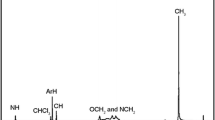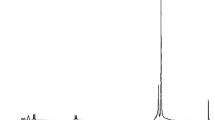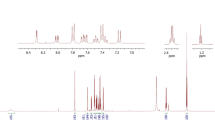Abstract
Click reaction of alkynylthiacalix[4]arene with ethyl 2-azidoacetate, followed by ammonolysis with hydrazine hydrate and Schiff-base condensation with benzaldehyde or salicyic aldehyde, afforded two novel thiacalix[4]arene derivatives containing multiple aromatic groups in yields of 86% and 90%. Their complexation properties for four organic dyes were investigated by liquid-liquid extraction experiments, complexation UV-Vis spectra and mass spectrum. The highest extraction percentage was 97% for Neutral red. The UV-Vis spectra and ESI-MS spectrum indicated the 1:1 complexes in DMSO solution. The association constants were as high as 1 ∼ 8×104 M−1. These complexation experiments showed that thiacalix[4]arene receptors possess excellent complexation capabilities for dyes.

Two novel thiacalix[4]arene derivatives containing multiple aromatic groups were synthesized in yields of 86% and 90%. These complexation experiments showed that thiacalix[4]arene receptors possess excellent complexation capabilities for four tested dyes.




Similar content being viewed by others
References
Wong Y and Yu J 1999 Water Res. 33 3512
Crini G 2005 Prog. Polym. Sci. 30 38
Peternel I T, Koprivanac N and Bozic A M L 2007 J. Hazard. Mater. 148 477
Crini G and Badot P M 2008 Prog. Polym. Sci. 33 399
Purkait M K, DasGupta S and De S 2004 J. Colloid Interface Sci. 270 496
Chakraborty S, Purkait M K and DasGupta S 2003 Sep. Purif. Technol. 31 141
Ghosh D and Bhattacharyya K G 2002 Appl. Clay Sci. 20 295
Al-Degs Y, Khraisheh M A M and Allen S J 2001 Sep. Sci. Technol. 36 91
Jana P R, De S and Basu J K 2003 Chem. Eng. J. 95 143
Wu F C, Tseng R L and Juang R S 2000 J. Hazard. Mater. 73 63
Prakash C, Jayaraman D and Pulla C 2013 J. Chem. Sci. 125 1455
Gunupuru R, Maity D, Bhadu G, Chakraborty A, Srivastava D and Paul P 2014 J. Chem. Sci. 126 627
Akceylan E, Bahadir M and Yilmaz M 2009 J. Hazard. Mater. 162 960
Yilmaz E O, Sirit A and Yilmaz M 2007 J. Macromol. Sci. A: Pure Appl. Chem. 44 167
Yilmaz A, Yilmaz E and Yilmaz M 2007 Dyes Pigm. 74 54
Kamboh M A, Solangi I B and Sherazi S T H 2011 Desalination 268 83
Kamboh M A, Solangi I B and Memon S 2011 J. Hazard. Mater. 186 651
Chen M, Shang T, Fang W and Diao G 2011 J. Hazard. Mater. 185 914
Hong B Q, Yang F F, Xu B T, Xie J W and Guo H Y 2012 J. Macromol. Sci. Part A 49 648
Yang F F, Zhang Y M, Guo H Y and Wei X L 2013 Separation Sci. Tech. 48 1565
Bai X Y, Yang F F, Xie J W and Guo H Y 2013 J. Macromol. Sci. Part A. 50 334
Guo H Y, Yang F F, Jiao Z Y and Lin J R 2013 Chin. Chem. Lett. 24 450
Bew S P, Brimage R A and Hermite N L 2007 Org. Lett. 9 3713
Connors K A 1987 In Binding Constants (New York: Wiley)
Beresnev D G, Itsikson N A, Chupakhin Q N, Charushin V N, Kodess M I, Butakov A I, Rusinov G L, Morzherin Y Y, Konovalov A I and Antipin I S 2006 J. Org. Chem. 71 8272
Acknowledgements
Financial support from the National Natural Science Foundation of China (No: 21406036), Fujian Natural Science Foundation of China (No. 2014J01034), Project of Fujian provincial department of education(JA11044) and the Program for Innovative Research Team in Science and Technology in Fujian Province University and Program for Excellent young researchers in University of Fujian Province (JA10056) are greatly acknowledged.
Author information
Authors and Affiliations
Corresponding author
Additional information
Supplementary Information
The electronic supporting information, including the characteristic data of new compounds and the complexation UV-Vis spectra for dyes are available at www.ias.ac.in/chemsci.
Electronic supplementary material
Below is the link to the electronic supplementary material.
Rights and permissions
About this article
Cite this article
YANG, C., WANG, Z., GUO, H. et al. Thiacalix[4]arene derivatives containing multiple aromatic groups: High efficient extractants for organic dyes. J Chem Sci 127, 1383–1388 (2015). https://doi.org/10.1007/s12039-015-0911-1
Received:
Revised:
Accepted:
Published:
Issue Date:
DOI: https://doi.org/10.1007/s12039-015-0911-1




